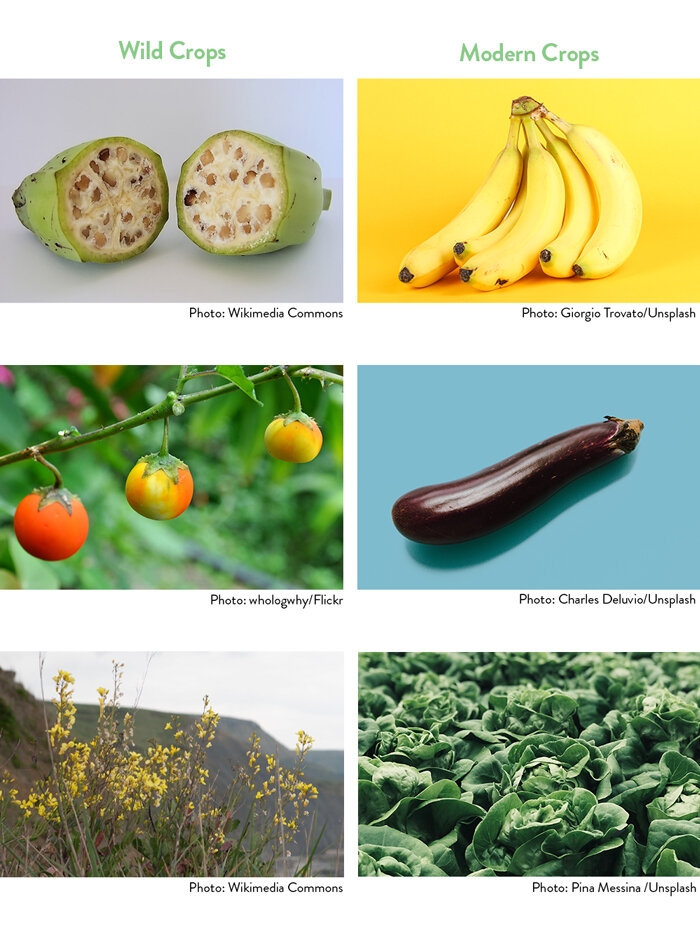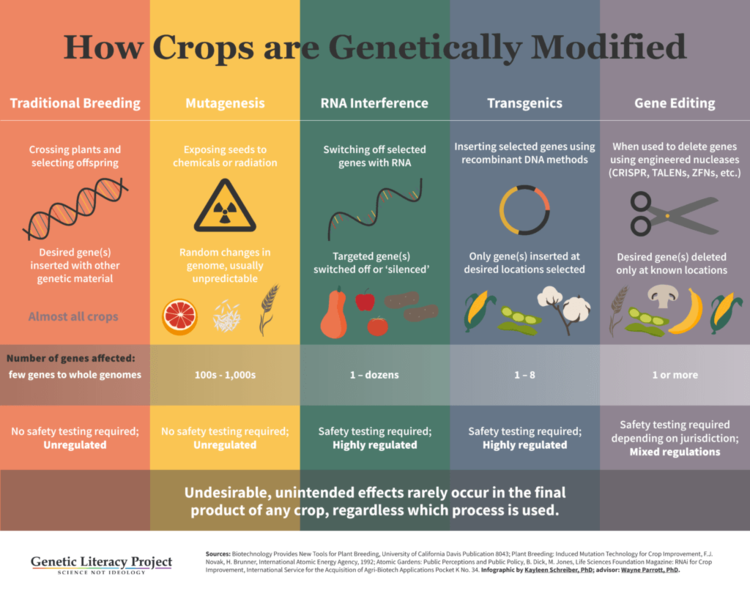By Greg Bryan, Ph.D., Chief Technology Officer, ZeaKal
Food affects all of us. As consumers, we care about how our food is produced, the ethics of its production and its impact on our environment. We want more transparency; yet information is often inaccessible, scientifically complex or riddled with misinformation.
Within food and agriculture, genetically modified organisms or “GMOs” are a controversial topic. It is a subject that now reaches far beyond the science and is a lightning rod for more complex issues surrounding food and agriculture.
Our blog series around GMOs aims to present a transparent and accessible narrative that will hopefully lead to more constructive dialogue. Read on to learn about the history of genetic improvements in agriculture and the important role GMOs will play in its future.
Food genetics: a brief history
Most of the fruits, vegetables, and grains we purchase today did not exist a few hundred years ago. In 2017, I presented a seminar to my colleagues and asked them to identify the wild cousins of common foods. To my surprise, only a few shared correct answers. These distant food relatives were unrecognizable. Most would have tasted awful and some would even have been quite toxic to protect them from predation. After all, plants did not evolve in the wild for our benefit but for their survival.
Crop improvement is as old as human civilization. At its core is a strategy to pursue greater genetic diversity: conferring plants with new desirable traits or characteristics. This often runs counter to how plants are programmed to be competitive in the wild.
The oldest form of crop improvement is plant breeding. Breeders look for desirable qualities (yield, composition, resistance to pests/diseases) in different, but compatible plants of the same species and bring them together.
Breakthrough innovations including mutagenesis, hybridization and genetic modification offered further improvements to the gains made from breeding.
Since 1927, over 1000 new plant varieties developed through mutagenesis, a technique that creates random mutations to increase genetic diversity. A great example for craft beer lovers such as myself is how mutagenesis improved the malting properties of barley.

Hybridization created important gains in yield (hybrid vigor) for crops such as corn and canola. Its benefits are seen in seedless bananas and broccoli.
Newer toolsets such as genetic engineering and editing provide an even greater diversity of genetic potential while offering more precise improvements in plants. Compared with x-ray mutagenesis—which created the ruby red grapefruit, but also hundreds of unknown mutations and/or deletions—gene editing can make precise changes without affecting the rest of the plant’s genome.
What’s the deal with GMOs?
Among all the methods for improving genetics, GMOs have the greatest potential for improving food and agriculture. They are also controversial.
From a scientific standpoint, GMO simply means an organism containing foreign genetic code in its genome. Here is the real kicker though: many plant species are naturally GMOs containing some form of foreign DNA.

Since plants are sessile (can’t move), they evolved to co-exist with the other organisms in their ecosystem. As a result, plants developed a tolerance for accepting transgenic material, which is why we are able to make GMO and gene-edited plants.
In some cases, this foreign DNA provides benefits to the plant and improves its survival. Thus, the new DNA is maintained through natural selection. In certain instances, it is beneficial to humans. Overtime we unknowingly continued to select for and preserve these naturally occurring transgenic traits. For example, several of the genes related to sweet potato flavor are actually bacterial genes that were naturally inserted via a bacterium called Agrobacterium around 8,000 years ago. As we continue to sequence the genome of more plants, the list of naturally occurring GMOs continue to increase: from bananas, to tea, hops (another favorite), peanuts, Surinam cherries and cranberries.
When we create GMOs, we take advantage of this same natural process. The most popular and precise method is Agrobacterium mediated transfers. Think of GMOs as a courier service for genetics: we prepare a gene of interest and get it on an agrobacterium vector for delivery into the plant’s genome. We then get confirmation of delivery that its properly inserted, fully accounted for and at the location we want.
Due to strict regulations around GM technologies, these crops are some of the safest because of how much oversight goes into developing them. In contrast, new genetics produced through older technologies like mutagenesis are in fact unregulated in several countries, simply because of the longevity in their use. To put this in perspective, it would be like saying that surgery on the battlefield with a hacksaw is safer than at the hospital with a scalpel.
GMOs play a critical role in our future
Both proponents and opponents of GM technology we want to produce affordable, nutritious food on a smaller environmental footprint. It is already challenging to achieve these goals individually. To achieve them collectively requires completely new breakthroughs. ZeaKal’s PhotoSeed™ technology aims to tackle several of these challenges with a two-gene trait.
PhotoSeed and other technologies that fall into the “GMO” bucket have the highest chance of introducing valuable traits with the most impact. While technologies such as mutagenesis and gene editing allow removal or small changes in gene function, GMO technology enables the addition of function (from other genetic sources of origin).
To reach a new plateau with our modern plant cultivars, we must give plants new tools beyond the code that is in their genomes today. It bears repeating that plants evolved for survival and not human benefit. We as humans want seeds and grain that have maximum yield, are more nutritious and can thrive in adverse conditions. However, the ancestral relative of a modern crop did not grow in a cultivated setting. It ensured its survival across the broadest set of scenarios. There was no selective force to improve its seed yields beyond what it needs for reproduction. Grain or seed composition was historically not about human nutrition but seed viability.
As we enter a new decade of environmental change, we should consider whether these powerful technologies can meet the challenges to come.

